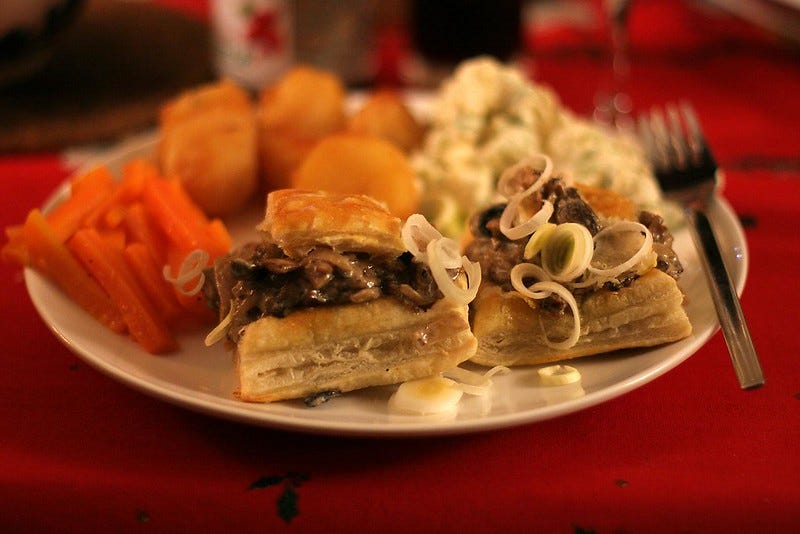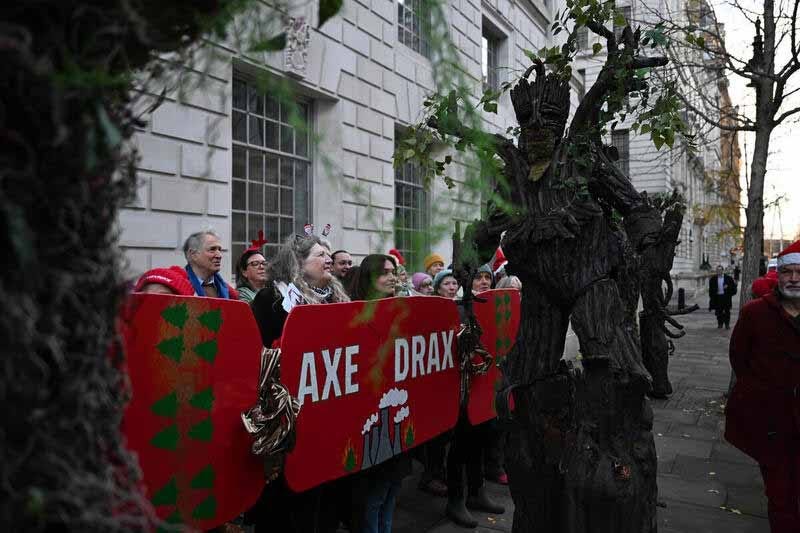5 ways to have a low(er) carbon Christmas
Without being a grinch! Plus the latest environment news from North Yorkshire and the North East
Good morning! I’m Sarah Hartley and this is The Northern Eco weekly update. As you’ve received this newsletter then either you subscribed, or someone forwarded it to you. If the latter, then you can click on this handy little button below.
I hope alls well where you are after the battering from Storm Darragh. Having these extreme weather events brings the need for individual action on carbon reduction into sharp relief so, with that in mind, I’ve something a little different for you today. But….. if carbon cutting’s not your thing, the usual news headlines are here too. Scroll down for news on Drax, Arla, solar farms, river investment and more….

Given the season of goodwill to all is also a huge festival of consumerism, having a really low carbon Christmas would be a tall order - but maybe there are some tweaks we can all take?
Having set myself this potentially fool’s errand, I started by turning to the book I consider something of a Bible in these matters - How Bad Are Bananas by Mike Berners-Lee.
He comes up with three scenarios - low carbon (4kg CO2e* per adult), UK average (280kg CO2e per adult) and high (1,500 kg CO2e per adult). He also looks only at excess i.e.unwanted presents, wasted food, avoidable travel, fairy lights and cards. He writes:
“I think the low-carbon scenario could be at least as festive and a lot less hassle.”
So with that in mind, here’s five ideas to help cut the carbon.
1. The tree
The Carbon Trust says that the question of whether a real or artificial tree is better for the environment is a hardy perennial discussion and there is no one right answer. The most sustainable choice will depend on the tree, your plans for reuse, then options for disposal. It advises:
An artificial tree, used over multiple years (7-20 years, depending on the weight and materials used) is better for reducing emissions than buying a new, commercially grown tree every year. There is however, the issue of plastic or metal elements which, depending on their recyclability, could become waste.
For real trees, those grown slowly and without fertiliser, are preferable to intensively grown options. Also look for trees grown locally, rather than options with higher transport emissions. We would suggest buyers check to see if a tree is certified by the Forest Stewardship Council.
Potted trees (with roots) are able to be re-used. This spreads the carbon footprint over multiple years and potentially avoids transport emissions by keeping the tree at the same property year-round. This makes them a more sustainable option if you’re after a real Christmas tree.
If you are buying a live tree each year, reuse your stand or pot for as many years as possible. Buying a new one each year has a significant impact on the footprint of your tree.
2. The decorations
Environmentalists have long been campaigning against glitter - the microplastic that finds its way to rivers and oceans and the EU banned loose plastic glitter that's smaller than 5 mm in size back in October 2023. This ban applies to glitter used in crafts and decorations so the message is simple here - ditch the glitter!
On other decorations, fairy lights burn through about 45 kwh so how about replacing them with LED lights?
3. The dinner
OK, this is the big one - would Christmas be Christmas without a table heaving with rich foods? Berners-Lee says that the average Brit spends £220 more than usual on food.
Then there’s the centre piece - what will be on your table? A vegetarian meal will have a lower carbon footprint than any meat based meal. But if meat is your treat then the traditional turkey has a lower footprint than beef.
For its Christmas dinner carbon breakdown, Sustainable Business magazine says:
“Topping the chart, lamb and beef are the biggest offenders as carbon footprint goes, with lamb clocking in an eye-watering 39.2 kilos of CO2 per kilo of meat (the equivalent of driving around 91 miles) according to Greeneatz. Beef is a little over ten kilos of CO2 per kilo better, with each kilo being equal to about 63 miles in a car or 27 kilos of CO2. The carbon footprint of the traditional Christmas turkey is less than half that of an equivalent amount of beef – only 10.9 kg of CO2 per kilo.”
For other meats, try this carbon calculator.
4. The gifts
Art and Climate writer Nicole Kelner has been considering how to select lower impact gifts. She says:
“Last year, I started a crowdsourced climate-friendly gift guide. If I’m going to buy something, I like to vote with my wallet by supporting brands that align with my values.
“Here it is: 250+ ideas for climate-friendly gifts! Some are brands, some are experiences, and some don’t cost a penny.”
Berners-Lee calculates that the average UK person spends £600 on presents of which 20% will be unwanted. He advocates for a bout of honesty where people are encouraged to be truthful in their reaction to the gift and, because you kept receipts, they can be returned with no hurt feelings.
If that sounds a bit too tricky to navigate, Friends of the Earth weigh up the options for giving away unwanted presents here and say:
“It’s no secret that the holiday season produces a massive amount of waste. In fact, waste goes up by 30% compared with the rest of the year. Shockingly, around £42 million worth of unwanted Christmas presents are sent to UK landfill every year. Instead of binning unwanted things, does it make more sense to give them away? Or is this too much of a social faux pas?”
5. The guests
As in our everyday lives, travel and transport is always one of the most carbon heavy activities we do so could some time spent planning make those journeys more environmentally friendly?
If a lot of people are travelling at the same time, is it possible to share a car or take public transport?
Obviously air travel should be avoided so could a video-call with distant relatives be the answer?
Any tips to pass on? Please do feel free to share any Christmas carbon hacks here.
*CO2e is the recognised way of measuring the equivalent of Carbon Dioxide emitted for any item. The average UK person has a carbon footprint of 12.7 tonnes each year. Research from Leeds University shows that two-thirds of global emissions relate directly or indirectly to household consumption. If you’d like to understand more about carbon and the climate, our training workshops are here to help.
In river news
💦 Yorkshire Water says it is investing £2m at a storm overflow to reduce the number of discharges into a tributary of the River Swale, reports Joe Willis at RichmondshireToday.
💦 The River Nidd could lose its bathing water status if it doesn’t improve, reports John Plummer at The Stray Ferret in its 10 point guide to what is happening at the river.
💦 Helena Horton at The Guardian has this exclusive report into the way the UK’s drinking water testing laboratories have all been closed down.
The three most clicked links from last week were:
In other news
Greenpeace campaigners delivered a 120,000 person petition to government last week as part of the fight to stop what they say are “destructive and unjust subsidies” given to the Drax biomass power plant.
They also joined with 100 campaigners from Axe Drax and other campaigning groups, for a protest outside the Department of Energy Security and Net Zero.
The campaign demands an end to the £1.5 million daily subsidies propping up the North Yorkshire power station. Check out the campaigner’s short video here.
⚡️ Plans for a large solar farm on farmland between Harrogate and Ripon are set for approval when councillors meet today (Tuesday). The scheme could provide enough energy to power 12,000 homes as Joe Willis reports at The Yorkshire Post. We’ll post an update on this via social media later today. (Where we are on social media)
🌳 The National Trust has submitted an application to Redcar and Cleveland Borough Council to cut around 100 trees at Ormesby Hall, largely because of ash dieback disease, reports Leigh Jones at the Teesside Lead. (The Teesside Lead is just one of many brilliant publications that uses the Substack platform we also publish on - you can explore all of them via the app.)
🐄 TikTok-ers, X commenters, political wannabes and youTubers have been busy spreading misinformation about the dairy herd food which supresses methane. After seeing videos of people wasting milk and binning butter on social media I took a look at the work some excellent fact checkers had done on this issue. Read my report on the facts surrounding this issue here.
🥗 A biodegradable energy plant that will turn waste into electricity and power homes is to be built in County Durham. The facility near Sedgefield, will process food waste and farmyard manure, producing methane gas which will be purified for the National Grid, writes Bill Edgar at The BBC.
🎖️Professor Alastair Fitter has received the prestigious Cadbury Medal in recognition of 50 years of service to nature conservation and the instrumental role he played in saving Yorkshire's, Askham Bog, announces The Wildlife Trusts.
🏭 Activists have long called for the controversial Tees Valley Energy Recovery Facility (TVERF) project to be abandoned, amid worries over the vast rubbish burner’s health and environmental impacts. But as Daniel Holland reports at North East Bylines, council bosses claim they have no viable alternative to the massive incinerator in Redcar.
🚜 The Wildlife Trusts and WWF are among numerous groups who have signed a letter to Environment Secretary Steve Reed raising the alarm about what they describe as unfair supply chains and funding for nature-friendly farming, report’s the Press Association’s Rebecca Speare-Cole.
And finally, a bit of personal news! I’m one of 20 UK journalists being considered for a Tenacious Journalist Award with two story pitches going off to the judging panel. The awards will be announced next year so please - wish me luck and keep those🤞. If my ideas pass muster, you’ll be the beneficiaries of some exciting environment stories in 2025!
See you next Tuesday by newsletter or be in touch on the website, app, chat or social media.
🌼 Thank you for reading edition number 110 of The Northern Eco. This newsletter remains independent, free unless you want to pay, ad-free and proudly reader supported thanks to paying subscribers. The main newsletter is sent out at 7am on a Tuesday and can’t exist without paying subscribers. Please do subscribe to keep it going - I can’t do it without your support. Thanks!






